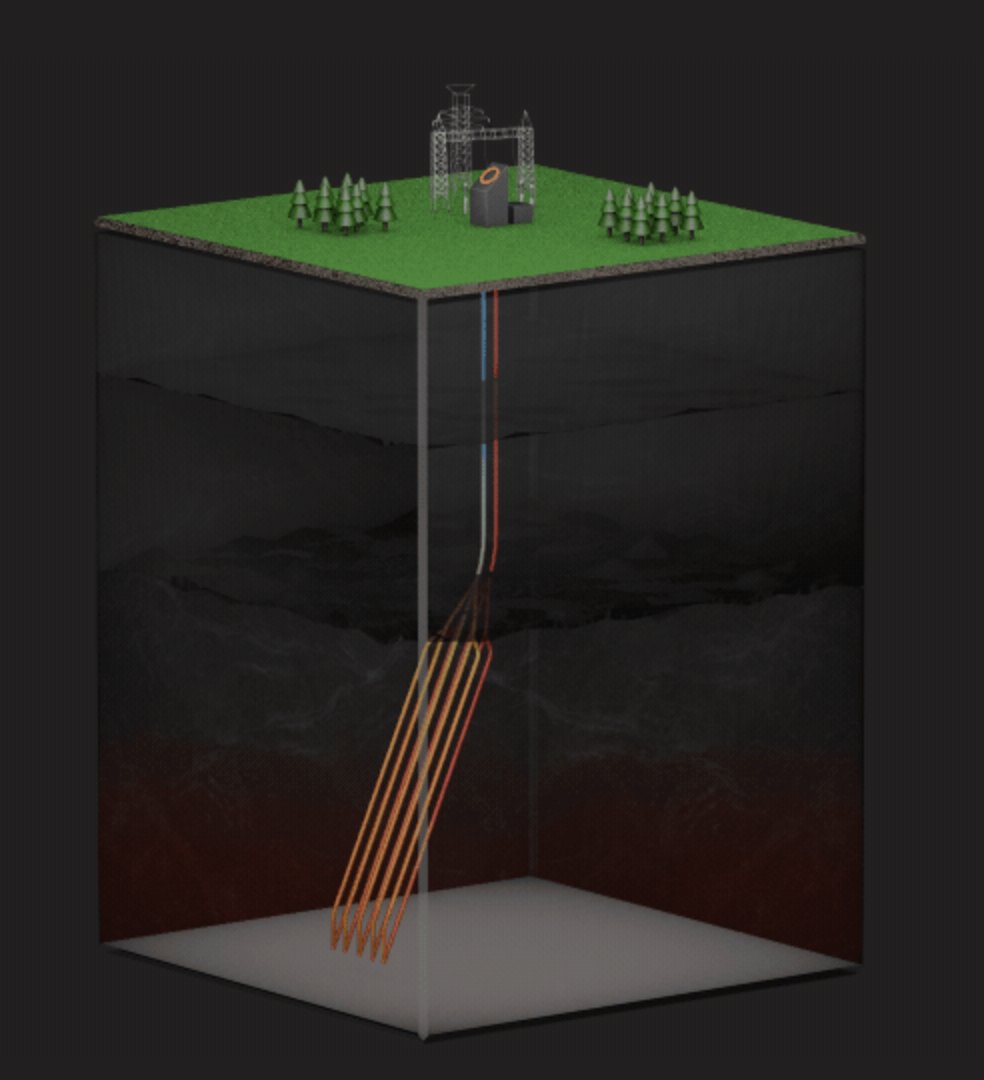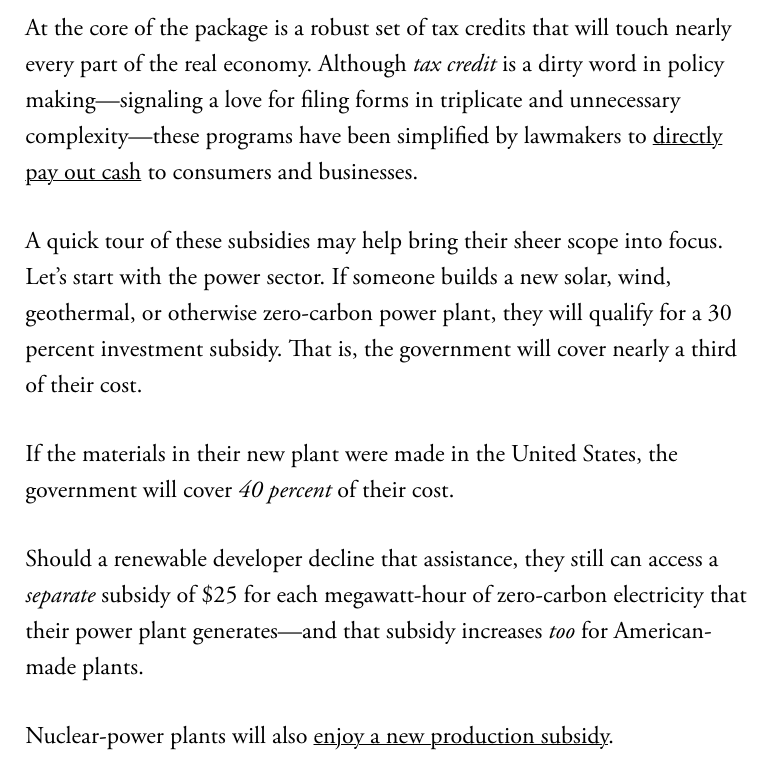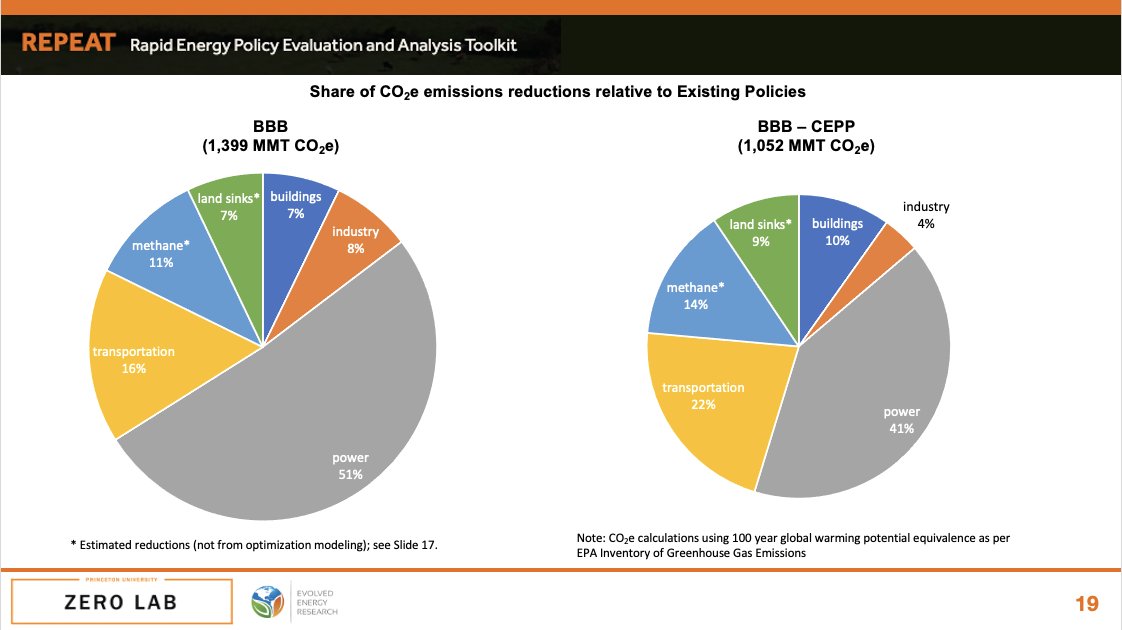
More details on the #ClimateAction provisions in #BuildBackBetter framework via @WhiteHouse, which they are (rightly) calling "The largest effort to combat climate change in American history" 🧵
.@WhiteHouse claims: "The framework will start cutting climate pollution now, and deliver well over one gigaton, or a billion metric tons, of greenhouse gas emissions reductions in 2030 – at least ten times larger than any legislation Congress has ever passed"
REPEATProject.org awaits details to model final bill, it appears BBB Framework retains most programs in the House budget bill, except the Clean Electricity Performance Program, while repurposing most of the $150b allocated for CEPP to strengthen & expand other programs.
If that's true & climate package in BBB Framework is roughly in line w/the House bill, it is very likely it can deliver the "well over a gigaton" of emissions reductions by 2030 claimed by the @WhiteHouse.
REPEAT Project found House BBB less CEPP delivered >1 gigaton by 2030.⤵️
REPEAT Project found House BBB less CEPP delivered >1 gigaton by 2030.⤵️

The fate of the methane fee, which we estimate is responsible for ~130 million tons of CO2-equivalent reductions is uncertain (some are reporting it's in, others out), but EPA regulation is coming soon on methane in oil & gas supply chains and can backstop or replace that if lost
Additionally, if most of the $150b for the Clean Electricity Performance Program (CEPP) was repurposed to other programs, that would move the final emissions reductions from BBB Framework closer to the 1.4 billion tons we estimated the full House bill would deliver.
So, without further detail, based on our REPEAT Project assessment of the House bill, it looks like the @WhiteHouse claims that the Build Back Better Framework will deliver "well over a gigaton" of emissions reductions by 2030 is very legit. Probably understated actually.
A fact sheet circulated to me via email from the @WhiteHouse has further detail that hints at what's still in the package. Here's some things the fact sheet references as in the Build Back Better framework...
"consumer rebates and ensure middle class families save money as they shift to clean energy and electrification ... include enhancement and expansion of existing home energy and efficiency tax credits, as well as the creation of a new, electrification-focused rebate program."
"The framework will cut the cost of installing rooftop solar for a home by around 30% ... the framework’s electric vehicle tax credit will lower the cost of an electric vehicle that is made in America with American materials and union labor by $12,500 for a middle-class family."
So from that, it sounds like significant consumer tax credits & rebate programs in House bill remain, incl. support for building electrification & efficiency, rooftop solar, and purchase of electric vehicles, with bonus tax credits for EVs & batteries made in USA by Union labor.
"In addition, the framework will help rural communities tap into the clean energy opportunity through targeted grants and loans through the Department of Agriculture."
So that sounds like measures in the House Agriculture Committee title are still in too.
So that sounds like measures in the House Agriculture Committee title are still in too.
BTW, see bit.ly/REPEAT-Policies for a list of all of the 40+ policies in the House Build Back Better Act that we assessed at repeatproject.org.
"Ensure clean energy technology – from wind turbine blades to solar panels to electric cars – will be built in the United States with American made steel and other materials, creating hundreds of thousands of good jobs here at home."
"The Build Back Better legislation will target incentives to grow domestic supply chains in solar, wind, and other critical industries in communities on the frontlines of the energy transition."
Sounds like bonus tax credits for solar & wind & EVs made in USA using US steel & materials contained in House bill remain in some form. That last line is reference to 48C tax credit for investing in clean manufacturing, which is targeted to automotive & fossil energy communities
"In addition, the framework will boost the competitiveness of existing industries, like steel, cement, and aluminum, through grants, loans, tax credits, and procurement to drive capital investment in the decarbonization and revitalization of American manufacturing."
I've been told one of the areas where funds originally set aside for Clean Electricity Performance Program were repurposed was to significantly expand funding for industrial decarbonization programs, including new things not in House bill. I look forward to seeing those details.
I have also heard reporting that increasing the 45Q tax credit for carbon capture and storage for industrial sources was on the table during negotiations and supported by the White House. I don't see it mentioned specifically in the fact sheet, so to be seen in leg text...
"Advance environmental justice through a new Clean Energy and Sustainability Accelerator that will invest in projects around the country, while delivering 40% of the benefits of investment to disadvantaged communities, as part of the President’s Justice40 initiative."
That's funding for a 'Green Bank' to underwrite investments in clean energy and efficiency across the country, wtih at least 40% of funding targeted to EJ communities.
"The framework will also fund port electrification; facilitate deployment of cleaner transit, buses, & trucks; and support ... community capacity building, incl. grants to environmental justice communities."
Important measures not just for CO2 but for air pollutants & health! 👏
Important measures not just for CO2 but for air pollutants & health! 👏
"framework will create new Civilian Climate Corps – with over 300,000 members ... This diverse new workforce will conserve our public lands, bolster community resilience, and address the changing climate, all while putting good-paying union jobs within reach for more Americans."
This Civilian Climate Corps was a major priority for @sunrisemvmt and others.
"Bolster resilience & natural solutions to climate change through historic investment in coastal restoration, forest management, and soil conservation. The framework will provide resources to farmers, ranchers, and forestland owners, supporting their efforts to reduce emissions."
"At its peak, the increased investments in climate smart agriculture alone could reach roughly 130 million cropland acres per year, representing as many as 240,000 farms." That's about 50% of US croplands! statista.com/statistics/201…
According to @EnergyInnovLLC analysis of the House bill, the agriculture and forestry provisions in that version would cut net emissions about 84-114 million metric tons. That's right in line w/ a trajectory to reach >50% below peak US emissions by 2030. 

That's the full scope of details mentioned by @WhiteHouse at this time. It does look from all of this -- topline $555 billion vs ~$600b in House bill + list of programs in WH fact sheet -- that the substantial heart of the House BBB climate package remains in the Framework deal.
That means that it's very likely that the Build Back Better Framework deal announced by @POTUS today will deliver the necessary emissions reductions to put the U.S. right on track for (or at least well within reach of) Biden's 2030 climate pledge to reach 50% below 2005 emissions
/end (for now!)
@threadreaderapp unroll please
• • •
Missing some Tweet in this thread? You can try to
force a refresh











